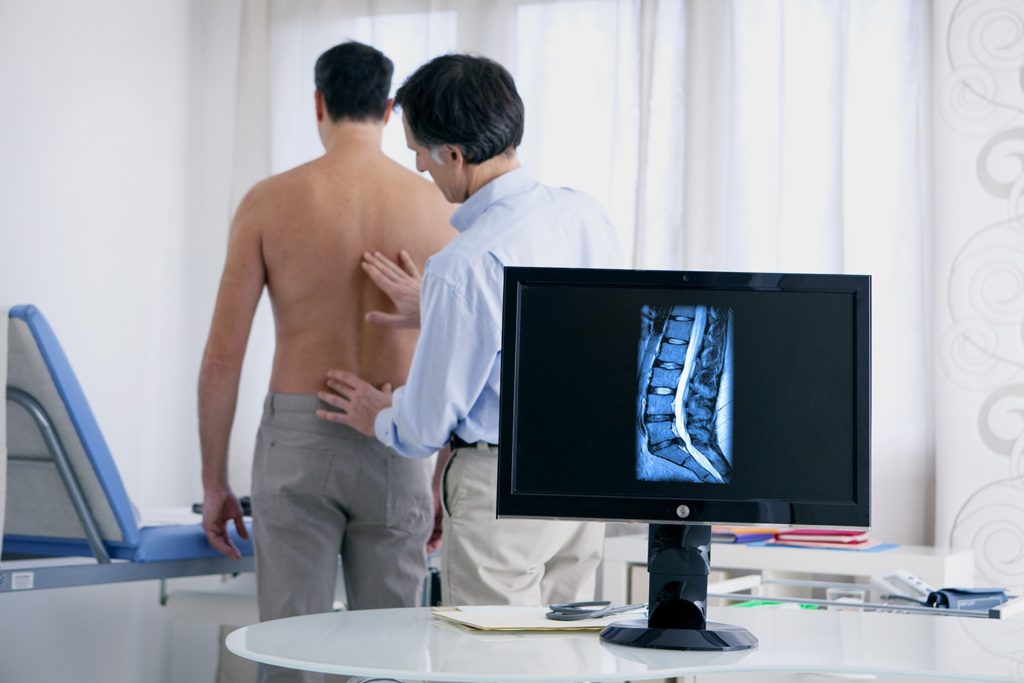Discopathy of the lumbar spine is one of the most common diseases of the spine. We explain the causes of this disease, what is the manifestation of lumbar discopathy and how it is diagnosed. We also present treatments for discopathy, including effective physical treatments that relieve pain and reduce muscle tone.

What is discopathy?
Discopathy is a pathology of the intervertebral disc, colloquially called a disc. It occurs as a result of a violation of the integrity of the annulus fibrosus and the outflow of the nucleus into the spinal canal. Discopathy, can cause compression of the spinal cord or nerve roots. This is the initial state of osteoarthritis of the spine. Most often occurs between the ages of 30 and 50.
Lumbar symptoms discopathy
The most common symptoms of lumbar discopathy are:
- Acute pain in the lower part of the spine, which is better when lying down and worse when walking.
- Pain can spread along the buttocks, thighs, knees, calf muscles, and toes.
- Increased tone of the paravertebral muscles.
- Numbness and sensory disturbances in the lower extremities.
- Muscle weakness.
- Bladder dysfunction.
Factors that increase the risk of lumbar discopathy
There are a number of factors that can increase the risk of lumbar discopathy. The most important of these are:
- injury or overload,
- incorrect weight lifting,
- a sedentary lifestyle that results in loss of tissue flexibility
- obesity and therefore increased pressure on the spine
- degeneration of the intervertebral disc caused by the progressive aging process
- anatomically narrow spinal canal.
Diagnosis of lumbar discopathy
If the symptoms we have described appear, especially sharp pain in the lower spine radiating to the lower body, you should immediately contact your family doctor, who will interview and refer images for appropriate research:
- computed tomography,
- X-ray of the lumbar spine
- magnetic resonance imaging.
Only with the aforementioned tests and a thorough history can it be determined whether the pain is caused by lumbar discopathy and at what stage the disease is.
Treatment of lumbar discopathy
In most cases, pain is treated conservatively with nonsteroidal anti-inflammatory drugs. However, the most important thing in this case will be correct rehabilitation. It should include:
- A position in a triangle in the hip and knee joints that brings relief.
- Manual therapy – neuromobilization and mobilization of the spine.
- Stretching and strengthening exercises. We apply after the acute condition has ceased. The physical therapist will customize the exercises for the patient.
- Kinesiotaping
- Physiotherapy
Of the physical methods, we especially recommend the following procedures:
- Tecar Therapy is a pleasant treatment that produces heat at the cellular level. We can apply it to tight paravertebral muscles to relax them and also reduce pain and tissue inflammation.
- Diathermy is also a pleasant procedure that we use to relieve pain.
- TENS-currents – to achieve anesthetic effect.
The goal of rehabilitation will be not only to reduce pain, but, above all, to reduce muscle tone and restore normal mobility in the spine. Rehabilitation should not be underestimated. Self-treatment with NLP can lead to a very rapid return of the disease.
It is also very important to change the lifestyle after discopathy, follow the principles of ergonomics of work and constantly introduce physical activity, such as swimming in the pool. It is recommended to swim with a crawl, which relaxes our vertebral muscles and strengthens our back muscles.
Surgical treatment is required in some cases. Usually these are people with advanced degenerative diseases, whose conservative treatment has no effect.
